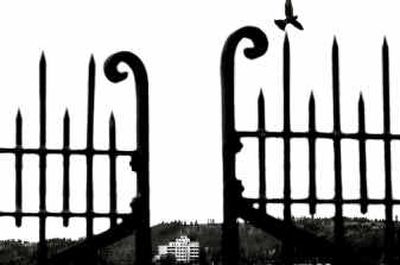In this place, past meets present and war-torn vets find peace

The Spokane Veterans Affairs Medical Center looks like a noble battleship docked after a long voyage. You can see the North Side building from many hillsides throughout Spokane, especially as the sun sets upon it each evening. It opened in 1950, and World War II veterans streamed there for care. They were still healing, emotionally and physically, from a war fought to keep the United States a safe place for its citizens.
The wars after that grew messier in purpose. Yet the VA, as everyone calls it, remained anchored in its North Side neighborhood, providing a healing place for veterans from throughout the Inland Northwest.
As you will read today in reporter Kevin Graman’s stories, national lawmakers continue to debate the mission of, and the funding for, VA medical centers throughout the United States. Demand for services has never been greater. Veterans are aging. And a 1996 law gave the VA legal authority to offer its services to any and all veterans, but it did not fund this open access. Demand will rise even more as military men and women return from Afghanistan and Iraq, wounded in body and in spirit.
These dollars-and-cents debates are important, yes. But they should begin, always, with the premise that our veterans deserve a clean and good place in which to heal. In Brian Plonka’s photos that accompany these stories, he captured this sense of place.
You see it in the photograph of the World War II veteran, tethered to the oxygen that allows him to breathe. He served in the South Pacific long ago, loading bombs on airplanes. Above him hang models of warplanes. Our older veterans need this place of welcome for their minds to wander safely into the past.
You see it in the photograph of the Native American man drying off after participating in a sweat lodge ritual to cleanse both body and soul. The VA building has remained steadfast in place for 54 years, but its care has evolved with the times. It now attends to the psychological needs of its clients, too, in a remodeled wing of soft carpeting and soft voices. And it attends to the soul needs through the sweat lodge outside and through a chapel inside, crowded every weekend for services.
If you have never been inside the VA, walk in sometime. Find the main waiting area under tall ceilings and a giant skylight. In this place, there is never silence. Veterans from many different wars, and veterans who served in peace times, reminisce here while waiting to see nurses and doctors. They know a common military language, and they speak it together.
If you are not a veteran, it is especially important to visit. Here, you can see clearly how these men and women showed up in battlegrounds during times of war, and in military posts in times of peace, and thereby filled enough of those places that the rest of us did not have to go. The places of war were filled with violence and loneliness and boredom. Some never made it home at all. Others returned with injuries to last a lifetime.
The country’s VA centers are funded by tax dollars contributed by those who served and those who did not. The debate on how much of the federal budget belongs to the centers is a necessary one.
But the starting point must always begin with this acknowledgment: These veterans labored for all of our freedom. They deserve a worthy place to go to receive our thanks.